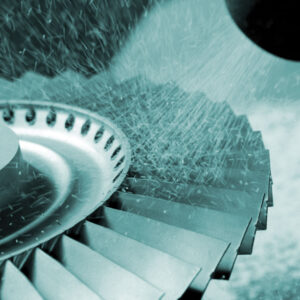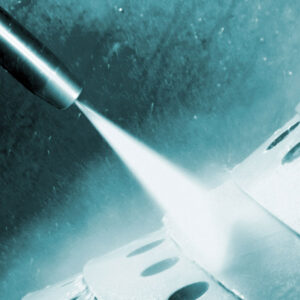The Beginning
Progressive opened in 1967 in Holland, Michigan, about 35 miles from our current location in Grand Rapids. The company was a small machine shop, primarily building part holding jigs and fixtures for the die cast polishing industry. Back in those days, chrome plating of plastics did not exist, so any small chrome-plated part of your car or industrial product was die cast, polished, and then chrome plated. The surface of the die cast part had to be polished prior to plating. There were many polishing facilities back in those days. In addition to the die cast polishing tooling, Progressive Engineering, as it was called then, also did job shop machining and fabrication for a company who built small manual abrasive blasting systems.
Shortly after Progressive Engineering got off the ground, someone finally figured out how to chrome plate plastic, and overnight, the die cast polishing industry evaporated as did most of Progressive’s revenue. At the same time as the fall of the die cast polishing world, Progressive’s customer, the small blasting and peening company, also went out of business. Since peening and blasting seemed to have a future and there was now an opening in the marketplace,Progressive chose this direction for the company and changed its name to Progressive Blasting Systems. Its primary business became the building of blasting and peening systems. One of Progressive Blasting’s first projects was a machine for Timex to cosmetically bead blast the wristbands of their watches. And to borrow the old Timex tag line, in those first few years of business, Progressive “took a licking but kept on ticking.”
Progressive’s early roots in machining formed the kind of equipment we build today. Where many of the early peening and blasting companies made machines from bent sheet metal, Progressive did not have sheet metal fabrication capability so we utilized our machining and welding capabilities and made our systems from machined and welded ½-inch steel plate. What we found was the welded plate construction created a structurally stronger, quieter, and more durable cabinet for the harsh and abusive pneumatic blasting processes. Through the years, as we added more manufacturing capabilities, this welded machined plate construction remained and has become part of our brand.
First breakthrough project
Through the late ’60s to early ’70s, most of our work was in support of the automotive and heavy equipment industry. We built many rotary index machines. At that time, indexing multi-spindle machines did not have automatic doors that opened and closed between indexing. Machine manufacturers used simple rubber curtains in an attempt to contain the media and sound. In 1968, Progressive was the first to put automatic doors on these machines, making the machines quiet and clean. Although it seems like an insignificant advancement, this started the movement of shot peening from a dirty, noisy, and problematic requirement to a much more respected and advanced surface enhancement process. During the rest of the 1970s, Progressive built many systems for large and small companies, from hand cabinets, to simple one-axis gun-mover systems with spindles, to rotary index-style machines. These machines went throughout the US to many different industries, including the aerospace industry.
Automation over hands
Late in the 1970s, Progressive was contacted by one of our aerospace customers with a big problem. They had a large fan case for an aircraft engine that required grit blasting as part of the manufacturing operation. This part was currently blasted manually. They were unhappy with the inconsistency they were getting with this manual process, not to mention the operator fatigue caused by the long cycle times. This customer wanted to know if there was an automated solution for processing this part.
Progressive needed to figure out how to coordinate two axis of required nozzle motion with an indexing turntable. The result was the first blasting machine with coordinated motion. The machine was a huge success because it improved process consistency and decreased cycle time. This machine cracked the barrier on automation, making it flexible enough to intricately blast or peen complex aircraft engine components.
Welcome to the age of robotics
Shortly after our first simple coordinated motion grit blasting machine, we were approached by Atlantic Machine Tool Works, a machine shop in Connecticut that produced turbine disks. Atlantic also peened the turbine disks that it machined in a conventional multi-nozzle peening system. Setup time consumed 50-60% of the hours Atlantic spent peening these disks. They had heard of our capabilities with simple coordinated nozzle motion and wanted us to build a two-axis machine to help reduce setup time.
Instead, Progressive convinced this customer that we could replace the five existing gravity suction nozzles with a single pressure nozzle on a five-axis robotic machine and get their parts done in half the time of the current process. That might be the standard sales pitch today for those who sell robotic systems, but back in 1982, this was unheard of and had never been accomplished before.
After many meetings, Atlantic believed in Progressive’s idea and the first multi-axis robotic shot peening machine was delivered and put into service in early 1983. This was the first of the over 1,000 robotic machines that Progressive would deliver during the next 35 years. Oh, and yes, not only did this machine deliver on the promise of eliminating setup time, saving 50-60% of the hours spent on the part, it went beyond the original goal. By robotically controlling that single nozzle, the part was peened more uniformly and closer to the 100% coverage requirement, and it lowered the actual peening time.
If one is good, two is better
Word quickly spread about our first robotic peening machine and soon we were working arm in arm with a major aircraft engine manufacturer. We were called in to work with their design engineering team to define the parameters to peen the first multi-stage compressor spool/drum rotor. This required us to develop the first dual-robot system—one robot to peen outside diameter, the other robot to simultaneously peen the internal surfaces. The inside was especially challenging since it required that the robot reach inside a six-inch diameter opening and articulate a peening nozzle to peen the internal surfaces of the multi-stage spool. Of course, once we figured out how to get a peening nozzle into that small space, we had to solve the next problem—how to extract the media from the inside of the spool. To tackle this problem, Progressive developed the first hollow spindle with integral media reclaim.
Necessity was definitely the mother of this invention.
What goes up must come down
After the first single-robot and dual-robot systems were introduced, the rest of the early 1980s were spent refining the designs of these systems and improving the robotic controls. Since most of these machines were being delivered to aircraft engine manufacturers, Progressive began to understand the needs of an industry that was starting to appreciate the benefits of shot peening and wanted more process control.
Early in these collaborative years, Progressive was presented with a problem and a concept. An engineer at a major aircraft engine manufacturer had the idea of using round, smooth, and very large media—ball bearings—to peen parts. He needed to densify a thermal sprayed coating and wanted to improve the surface finish of the final product.
Other methods of surface finish improvement after peening, such as tumbling, were not acceptable since they would remove this protective coating. This engineer mocked up his idea but needed help in taking this new process from concept to reality. The engineers at Progressive got busy and quickly designed and built the world’s first Gravity Accelerated Shot Peening (GASP) system. There were many technical challenges along the way, including the transport of 10,000 pounds of media per minute and then distributing thismedia in a uniform curtain. This project was a true testament to Progressive’s philosophy of working with customers to help them bring ideas to reality.
We need control
In addition to the high volume of peening work in the 1980s, Progressive was also busy developing high-technology thermal spray coating systems for aerospace customers. We were the first to design and build a closed-loop process controller for plasma spraying that incorporated closed-loop control of the plasma gases and powder feed rates. This was significant for the peening world since this work on our thermal spray process controller was the predecessor to PRIMS, our industry-leading Process, Reporting, and Integrated Monitoring System.
PRIMS monitored all the key peening process variables, alarming the operator and shutting down the machine if these variables went out of range. It also collected data to produce end-of-run reports. These reports were important to customers who were peening critical components and wanted verification that the peening was done correctly. Over the years, PRIMS has been continually improved by adding many user interface functions and preventative maintenance tools.
Lasers come to peening
The robotic systems Progressive produced during the 1980s and early 1990s established the company as a technology leader. There were many examples of Progressive working with customers to come up with innovative solutions for the peening of complex hardware. The problem with these accomplishments is that customers started to expect the impossible.
Early in the 1990s, engineers from a large aircraft manufacturer wanted to robotically peen the edges of very large aluminum wing skins, including the inside surface of cut outs within the skin. This was a challenge way beyond thinking. Not only did the special right-angle duck-bill nozzles have to be developed, but somehow we would have to track the edge of the skin to know where it was and how far away it was in order to maintain a consistent standoff distance.
After an exhaustive R&D effort, Progressive figured out how to utilize a laser to track the edge of the wing skin and then to integrate the feedback from the laser to automatically adjust the robot program to allow tracking of the part. Of course, all of this high-tech equipment needed to be on the end of a robot arm that could survive the harsh peening environment. These systems were a huge success and are still in operation 25 years after the initial installation.
Today and the next 50 years
These are only a few of the 2000 projects Progressive has completed over the past 50 years. These projects shaped the company into a leader in the surface treatment machinery industry. Over the years, Progressive’s philosophy of helping customers solve problems has created numerous opportunities and opened many new technologies and industries.
From our early days of building blasting and peening systems, these opportunities have allowed us to also become industry leaders in thermal spray coating and waterjet stripping systems. A true testament to Progressive’s commitment to building the best machine possible is illustrated by the fact that all of the machines discussed above are still in production today—some have over 30 years of service. That’s unheard of in the blasting equipment industry.
From the start, Progressive has focused on gaining a thorough understanding of our customers’ requirements, developing the necessary technology to produce process specific solutions, and then providing a lifetime of exceptional support. This is the Progressive brand, and this successful approach will continue for the next 50 years.









